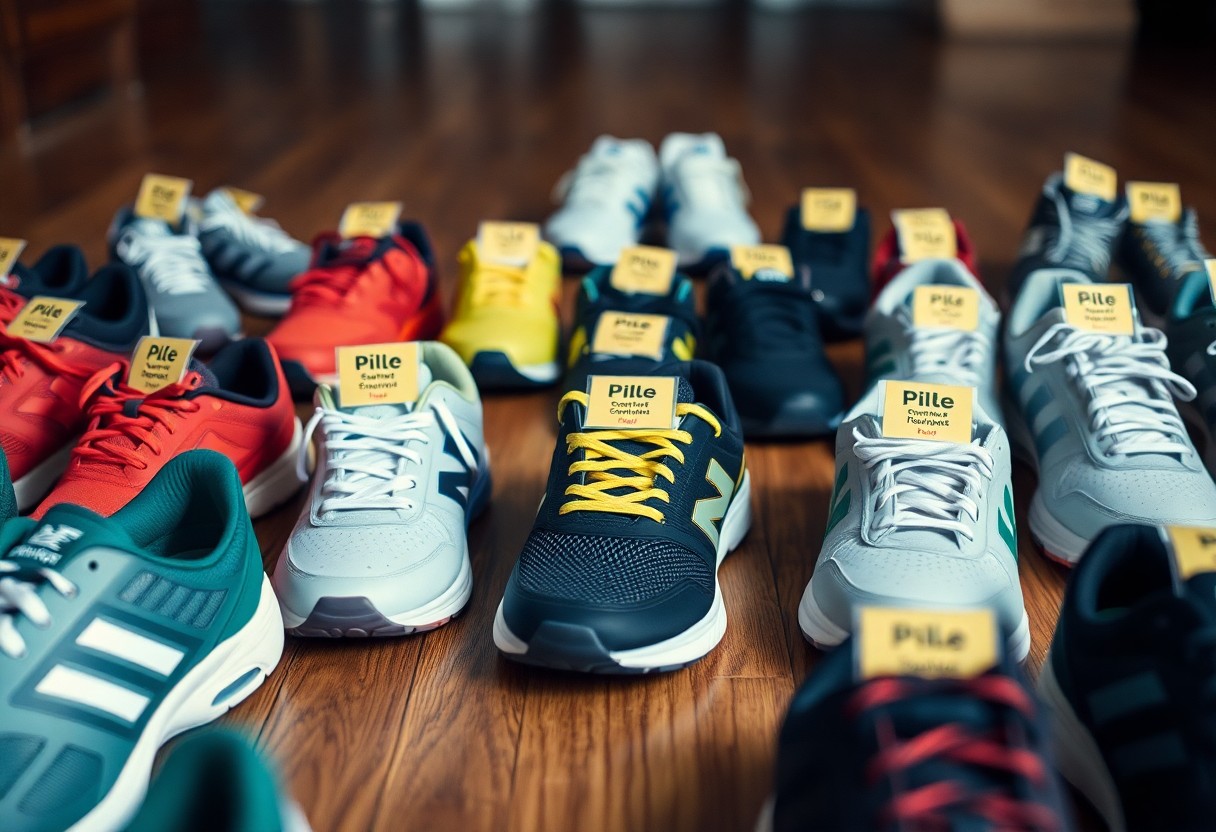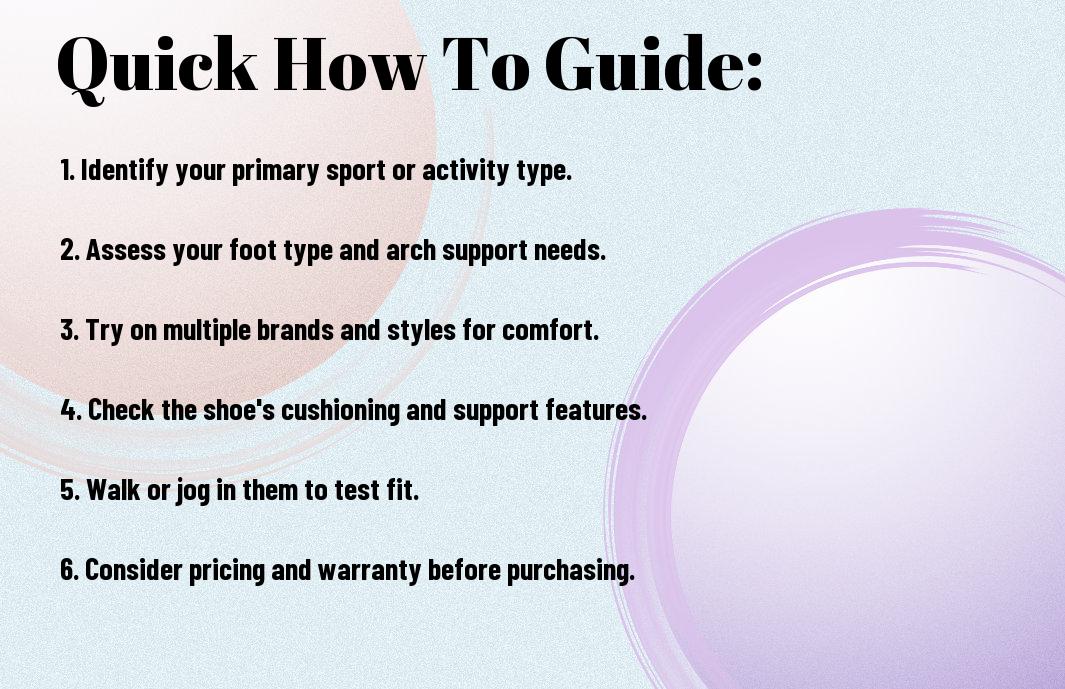Just like selecting the right pair of shoes for running, choosing the appropriate equipment for your sport can greatly enhance your performance and enjoyment. This guide will help you navigate the myriad of options available, ensuring you make informed decisions tailored to your specific needs and preferences. From understanding the vital features of gear to balancing quality and budget, you’ll learn how to equip yourself for success in your athletic pursuits. Let’s look into the key factors to consider as you initiate on this important journey.
Key Takeaways:
- Consider your sport: Understand the specific demands and requirements of your sport to guide your equipment choices.
- Research brands and models: Compare different brands and models to find high-quality, reliable equipment that suits your needs.
- Fit and comfort: Ensure the equipment fits properly and feels comfortable; this can enhance performance and prevent injuries.
- Budget wisely: Set a budget that balances quality and affordability, as investing in good equipment can pay off in the long run.
- Seek expert advice: Consult with coaches, experienced athletes, or retailers for recommendations tailored to your specific sport.
Understanding Your Sport
As you initiate on your journey to select the right equipment, it’s crucial to grasp the fundamentals of your sport. Each sport has unique demands that influence the type of gear you’ll need. Understanding your sport not only enhances your performance but also ensures that you remain safe and enjoy your experience. With the right knowledge, you can make thoughtful choices that elevate your game and protect your well-being.
Analyze the Requirements
Even the most popular sports come with a variety of equipment needs, from basic to advanced. Assessing what gear is necessary based on your skill level, playing conditions, and competition type will provide a strong foundation for your selection. Look into guidelines and recommendations specific to your sport to avoid overspending or purchasing unnecessary items.
Identify Performance Needs
Now that you have a basic understanding, you should focus on what performance traits are crucial for your success. Consider aspects such as speed, agility, comfort, and durability when evaluating different equipment options. These factors play a vital role in your overall performance and can differ greatly depending on your specific sporting activity.
For instance, if you’re participating in a sport that requires quick directional changes, you’ll need footwear that offers superior grip and flexibility. Alternatively, if you’re focused on endurance, you might prioritize clothing made from breathable materials to wick away sweat. Each sport will have distinct performance needs that can help guide your equipment choices effectively, enhancing your playing experience.

Key Factors to Consider
It’s important to evaluate several key factors when selecting the right equipment for your sport. Consider the following:
- Type of sport
- Skill level
- Physical condition
- Budget
- Brand reputation
Recognizing these elements will help ensure the equipment you choose aligns with your specific needs and enhances your performance.
Comfort and Fit
Factors like comfort and fit play a significant role in your overall experience. Equipment that feels good against your body and conforms to your specific shape allows you to perform better and focus on your sport without distraction.
Durability and Longevity
To ensure your investment is worthwhile, it’s vital to prioritize durability and longevity when selecting sports equipment. Equipment made from high-quality materials can withstand wear and tear, providing you with reliable performance for a longer period.
Understanding the importance of durability means thinking about how often you will use the equipment and the conditions it will face. For instance, if you partake in outdoor sports, look for gear that is weather-resistant and robust. This foresight not only saves you money in the long run but also enhances your confidence in your equipment, allowing you to focus on excelling in your sport.
How to Assess Equipment Quality
Once again, evaluating the quality of sports equipment is imperative for enhancing your performance and ensuring safety. Look for materials and craftsmanship that meet industry standards, as well as adherence to any applicable regulations. Pay attention to details like stitching, seams, and component resilience. Additionally, assess how well the equipment fits your specific needs, as a perfect match can greatly influence your experience and enjoyment of the sport.
Research and Reviews
To make an informed decision, examine online resources and customer reviews about the equipment you are considering. Various platforms provide insights from other athletes, highlighting performance levels, durability, and overall satisfaction. You can also find expert product comparisons, which can streamline your selection process and provide clarity on the best options available in your category.
Brand Reputation
Some brands have established themselves as industry leaders due to their commitment to quality, innovation, and customer satisfaction. When assessing equipment, consider the brand’s history and reputation among athletes. A brand that consistently delivers high-quality products is more likely to provide reliable equipment that meets your expectations and needs.
Understanding a brand’s reputation involves researching their years in the market, customer feedback, and endorsements from professional athletes. Established brands that invest in research and development typically offer better warranties and customer service, which can be imperative if you face issues with your equipment. Choosing a reputable brand can provide peace of mind, allowing you to focus on your sport with confidence in your gear.
Tips for Budgeting
All sports enthusiasts should establish a realistic budget to avoid overspending on equipment. Consider allocating funds specifically for sports gear and keep track of your expenses. Here are some practical tips to help you budget effectively:
- Research prices before purchasing.
- Set aside a specific amount for each item.
- Evaluate the necessity of each piece of gear.
- Look for packages that offer equipment combined.
This approach will enable you to manage your finances while still acquiring quality equipment.
Setting Priorities
Little adjustments in your spending habits can lead to better choices and more effective use of your budget. Prioritize which pieces of equipment are crucial for your sport. Distinguishing between must-have items and those that can wait allows you to focus on the necessities first. Ensure that each item on your list directly supports your performance or safety.
Finding Sales and Discounts
You can significantly reduce your expenses by staying on the lookout for sales and discounts. Use online resources, join mailing lists, and follow your favorite brands on social media to be informed about special offers.
Priorities should guide your shopping strategy. When you spot a sale, get what you need while ensuring that it meets your quality standards. Websites often have seasonal promotions, and local stores may provide discounts during events or end-of-season sales. Don’t hesitate to compare prices across different retailers. Your diligence in finding these deals can lead to substantial savings, allowing you to invest in other aspects of your sport.
Trial and Error
For athletes, finding the right gear isn’t always straightforward. It often requires a process of trial and error, where you test different options to discover what works best for your specific needs. By experimenting with various brands, styles, and features, you can learn which equipment enhances your performance and which may hinder it. Be patient, and embrace the learning experience that comes with this trial-and-error approach.
Testing Equipment
With the right testing method, you can effectively evaluate different pieces of equipment before committing to a purchase. Look for opportunities to try out gear at local sporting goods stores, rental services, or community sports events. Pay attention to how the equipment feels during use and whether it meets your performance expectations.
Seeking Expert Opinions
Error can be avoided by consulting experts who have a wealth of experience with various types of sports equipment. They can provide guidance tailored to your specific needs, helping you navigate the vast options available. Don’t hesitate to lean on coaches, professional athletes, or knowledgeable salespersons to gather insights and recommendations.
The insights you gather from these experts can help streamline your decision-making process. Their firsthand experiences can guide you away from products that may seem appealing but aren’t suited for your sport. Joining forums, reading reviews, and attending workshops can also enrich your understanding and inform you about the latest technologies and trends in your chosen sport. By leveraging expert opinions, you can confidently invest in equipment that complements your athletic journey.

Maintenance and Care
Your sports equipment requires regular maintenance and care to ensure longevity and optimal performance. Taking the time to clean and inspect your gear will help prevent any unnecessary wear and tear. For more detailed information, consider checking out this Sports Equipment Buying Guide that outlines vital factors to consider in your maintenance routine.
Proper Cleaning Techniques
Clearly, maintaining your sports gear starts with proper cleaning techniques. Different materials require specific cleaning methods; for example, synthetic fabrics can often be machine washed, while leather goods may need specialized cleaners. Always refer to the manufacturer’s instructions for optimal care.
Storage Recommendations
One of the best ways to extend the life of your sports equipment is through proper storage. Store your gear in a cool, dry place, away from direct sunlight, to prevent damage from moisture and UV rays. Use protective covers or bags as needed and ensure that items like shoes and pads are not packed too tightly, allowing them to maintain their shape.
Care for your equipment goes beyond just cleaning; it also means ensuring that storage conditions are ideal. Consider using dedicated storage bins or hooks to keep your items organized and easily accessible. Regularly check for any signs of wear, and promptly address any issues to avoid more significant problems down the line.
To wrap up
From above, selecting the right equipment for your sport involves a thoughtful evaluation of your specific needs, skill level, and budget. You should assess the features that best support your performance and comfort while also considering the quality and durability of the gear. By doing thorough research and seeking expert advice, you can make an informed choice that enhances your athletic experience and helps you reach your goals effectively.
FAQ
Q: What factors should I consider when selecting equipment for my sport?
A: When choosing equipment for your sport, consider several factors including your skill level, the specific requirements of your sport, and your budget. For beginners, it may be wise to look for equipment that offers flexibility and adaptability as you develop your skills. Additionally, research the specific gear needed for your sport, as different activities can have varying requirements. Finally, factor in your budget to ensure that the equipment you select meets your needs without overspending. Exploring both new and used options can help you balance quality and cost.
Q: How do I determine the best size and fit for my sports equipment?
A: The size and fit of your sports equipment is vital for both safety and performance. For apparel and footwear, refer to the size charts provided by manufacturers and, if possible, try on items before purchasing. For gear such as bicycles or helmets, ensure that the specifications match your measurements and the product offers adjustable features where applicable. Consulting with professionals at local sporting goods stores can provide assistance tailored to your body type and activity level to enhance comfort and performance.
Q: Should I prioritize brand names when buying sports equipment?
A: While brand reputation can be indicative of quality, it’s important to evaluate products based on performance and reviews rather than just brand names. Research products through user reviews, expert recommendations, and product tests to ensure you’re making an informed decision. Sometimes lesser-known brands may offer competitive features at a more affordable price. Ultimately, focus on equipment that meets your specific needs, provides comfort, and enhances your skills regardless of the brand name associated with it.

